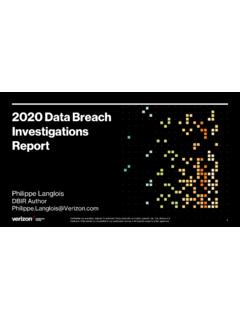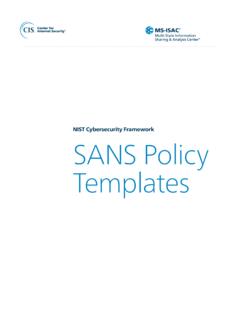Transcription of Cybersecurity Tech Basics Vulnerability Management …
1 2018 Thomson Reuters. All rights the Resource ID numbers in blue on Westlaw for more. Resource ID: w-013-3774 Cybersecurity tech Basics : Vulnerability Management : OverviewSEAN ATKINSON, CIS (CENTER FOR INTERNET SECURITY), WITH PRACTICAL LAW INTELLECTUAL PROPERTY & TECHNOLOGYA Practice Note providing an overview of what cyber Vulnerability Management programs are, how they work, and the key role they play in any organization s information security program. This Note discusses common types of cyber vulnerabilities and core process steps for implementing and maintaining a Vulnerability Management program to decrease Cybersecurity risks. It also addresses common pitfalls that can lead to unnecessary cyber incidents and data organizations depend on a combination of commercial and custom-developed hardware and software products to support their information technology (IT) needs.
2 These technology components inevitably include vulnerabilities in their design, setup, or the code that runs them. Cyber vulnerabilities, coupled with growing threats, create risks by leaving organizations open to attacks, data breaches, and other cyber incidents. These events often lead to regulatory enforcement, litigation, or credibility loss. Organizations and their counsel must understand these risks and address Vulnerability Management in a well-defined and managed information security Note provides an overview of what cyber Vulnerability Management programs are, how they work, and the important role they play in any organization s information security Management DEFINEDV ulnerabilities are weaknesses or other conditions in an organization that a threat actor, such as a hacker, nation-state, disgruntled employee, or other attacker, can exploit to adversely affect data security.
3 Cyber vulnerabilities typically include a subset of those weaknesses and focus on issues in the IT software, hardware, and systems an organization uses. For example: Design, implementation, or other vendor oversights that create defects in commercial IT products (see Hardware and Software Defects). Poor setup, mismanagement, or other issues in the way an organization installs and maintains its IT hardware and software components (see Unsecured Configurations). Vulnerability Management programs address these issues. Other common vulnerabilities that organizations must also tackle in their information security programs include: Gaps in business processes. Human weaknesses, such as lack of user training and awareness. Poorly designed access controls or other safeguards. Physical and environmental threats, organizations can often directly control their vulnerabilities and therefore minimize the opportunities for threat that develop their own in-house software should use security by design techniques to avoid creating vulnerabilities.
4 For more information on assessing overall data security risks and related legal considerations, see Practice Note, Data Security Risk Assessments and Reporting (W-002-2323) and Performing Data Security Risk Assessments Checklist (W- 0 02-7 5 4 0). Vulnerability Management programs: Define a formal process to: ztimely identify applicable vulnerabilities; zclose the security gaps that vulnerabilities create by remediating or at least mitigating their effects; and ztrack and document an organization s efforts. Prioritize often limited IT resources. Organizations must focus on vulnerabilities according to their level of risk, particularly considering the sheer volume of changes that diligent Vulnerability Management can demand. Continuously monitor and evaluate an organization s IT environment to ensure compliance and avoid re-introduction of known vulnerabilities.
5 2018 Thomson Reuters. All rights reserved. 2 Cybersecurity tech Basics : Vulnerability Management : Overview Minimize cyber attack risks by decreasing the number of gaps that attackers can exploit, also known as the organization s attack sur face. Some refer to Vulnerability Management programs as patch Management because vendors often provide software patches or updates that organizations can apply to remediate their systems. However, applying patches is only one means of managing some vulnerabilities. Organizations can also protect themselves by using secure configurations and defense-in-depth techniques that layer multiple security controls. Sound Vulnerability Management programs take a broad view and leverage patching and other Management programs play an important role in any organization s overall information security program by minimizing the attack surface, but they are just one component.
6 For details on the key steps for implementing a formal Vulnerability Management program, see How Vulnerability Management Programs Work. For information on building a comprehensive information security program, see Information Security Toolkit (W-002-8679).HARDWARE AND SOFTWARE DEFECTSD efective hardware and software products are the source of many cyber vulnerabilities. Vendors fail to follow security by design principles or fully test their products. The tactics, techniques, and procedures (TTPs) that attackers use have grown increasingly sophisticated. Changing TTPs mean that some vendors designs may not have contemplated certain attack strategies. Attackers also range from unskilled amateurs, known as script kiddies, that use other hackers tools to malicious insiders, activists, criminals, and highly funded nation-state actors. For more information on common cyber attacks, see Practice Note, Cybersecurity tech Basics : Hacking and Network Intrusions: Overview (W-003-3498).
7 This heightened threat climate results in a larger number of identified vulnerabilities. Vendors typically identify hardware and software product vulnerabilities using several methods, including: Testing. Vendors perform their own product testing, and in some cases, employ internal or external security specialists that focus on discovering and fixing vulnerabilities. These specialists are usually called white hats, red teams, ethical hackers, or in the case of external experts, penetration testers. Building in strong security measures or fixing identified vulnerabilities often competes with other business priorities. This conflict and the complexity of full security testing for many products, especially given attackers changing TTPs, results in distributed products that still contain vulnerabilities. Active exploits. Vendors may learn of product vulnerabilities only after attackers exploit them and victims, law enforcement, or other incident responders identify them as the attack s cause.
8 These unfortunate situations are called zero-day vulnerabilities. Vendors generally have time to provide a fix for identified vulnerabilities before attackers exploit them. Here that is not the case, hence the zero-day term. Some actors, including governments, allegedly identify and hoard vulnerabilities, using them to attack others rather than timely notifying vendors. Bug bounty and Vulnerability disclosure programs. Formal Vulnerability disclosure programs and policies set boundaries for security researchers, commit organizations to avoid legal action if others follow their policies, and provide guidance on how to notify them of identified vulnerabilities. Some organizations provide cash or other incentives to encourage good-faith responsible security researchers. The incentives are typically known as bug bounty programs. Several specialist companies offer bug bounty program Management and support services and are well-known in the security researcher Vulnerability identification, vendors generally provide a software patch or other fix using an advisory.
9 Hardware defects can be more challenging to remedy in current products, although vendors may provide software fixes or information on mitigation techniques. Industrial control systems and the increasing use of internet of things (IoT) devices present additional opportunities for hardware defects. These products can be: More Vulnerability -prone due to manufacturers too frequent lack of security focus and expertise. More difficult to remediate because of their limited user interfaces and lack of update more information on gathering vendor advisories, see Maintaining Awareness and Detecting CONFIGURATIONSI mproper configurations or poor system Management can cause cyber vulnerabilities even in fully patched hardware and software components. Factory-default settings may include easily guessed passwords or leave unnecessary services organization s IT environment and business needs are unique.
10 Reviewing typical device and software categories allows an organization to recognize and avoid potential vulnerabilities, by considering, for example: Network elements. Various network elements, such as routers, switches, and firewalls, provide internal and external connectivity and control network traffic. Organizations configure these devices with rules to distinguish potentially malicious traffic from legitimate data flows. Incorrectly applied rules, misconfigured access controls, or unnecessarily open hardware and software entry points or ports can: zcreate unnecessary vulnerabilities; and zmake the organization vulnerable to network intrusions and data theft or exfiltration. Servers. Organizations often maintain their own servers for various IT functions, including end user file sharing and printer support, databases, applications, and websites.












